What Is the Best Introduction into Revisionism?
People have asked me repeatedly over the past twenty-five years or so what book or video I think is the best to recommend to a newcomer to Holocaust revisionism, or even to a person who has not yet opened their mind to the idea of questioning the orthodox Holocaust narrative.
At the same time, I have listened to many personal stories of how people from all walks of life had their “Damascus” experience unfold, to use this biblical expression. Which book or movie set them on this journey that made them doubt and eventually reject the orthodox narrative? Adding my own experience of conversion to this mottled mix of personal stories, I think it is safe to say that there is no silver bullet in the revisionist arsenal of weapons of mass instruction that will lead to certain conversion. Each story I have heard is different, often very radically so.
The reason for this, I have come to understand, lies in the fact that we are all very different on many levels, reacting distinctly differently to a broad variety of stimuli. Those who do not like poring over printed material but prefer images might not react to any book, and might not even read a well-crafted leaflet with the attention it deserves. In today’s world dominated by YouTube and other streaming platforms, the number of people has grown dramatically who need instant, no-effort reward of their visual cortex to react at all. While there are a number of revisionist videos catering to this group, I think that much more can and needs to be done to attract and accommodate this growing group of people. Currently, the best place to go for this is CODOH’s collection of Holocaust Documentaries collected at HolocaustHandbooks.com/documentaries/. More modern and more-professionally made video projects are in the making as I type this, but they will take time to come to fruition, as they are more expensive to produce than books. Furthermore, videos cater to a market that expects free access, meaning that producing expensive video material usually results in no income at all, so it crucially depends on donations.
Those who prefer reading texts over video material, because they (correctly) hope to find a higher density of more-profound information in it, can be split into various groups according to different personality traits:
1. Attention Span
Is a reader willing to read a double-sided leaflet? A 20-page brochure? A book of 20,000 words? 27,000 words? 54,000 words? 102,000 words? 240,000 words? 280,000 words? 393,000 words? (See the table below for the word counts of books discussed here.) When I was in my discovery phase, I couldn’t get enough of this, so I was longing for the deep-delving book having 1,000 pages (which didn’t exist back then). Once a book managed to get me riveted to its pages, it made me forget times and space. I ended up being sorely disappointed once it ended. I wanted more. But this voracity is not the norm, particularly not at a person’s beginning of his journey of discovery. Back in the 1970/80/90, the standard among publishers for a book with good prospects of becoming a commercial success was that it should have somewhere between 200 and 350 pages (50,000 to 120,000 words, depending on how it is formatted). Anything pushing beyond 400 pages usually deters the average reader. While they might appreciate a longer book once they have found out that it’s a great read, the biggest challenge to reel in new readers is to get them to start reading. One of the biggest impediments to achieve this is a book that looks dauntingly thick and time-consuming. But these are statistical observations. The initial attention span and willingness to invest time and effort varies greatly, and to some degree depends on other personality traits.
2. Literacy
A reader’s willingness and ability to read depends very much on their literacy, which does not just mean that they can read in the first place, but also whether or not, and if so to what degree, they are used to read, and in the habit of reading, written material in the first place. Furthermore, even voracious readers of mass-market fiction material may not be tuned to read non-fiction material, hence encounter difficulty with this genre that has at times a low “entertainment” value.
3. Education and Intelligence
While there is some correlation between education and intelligence – the more intelligent a person is, the more they usually tend to receive a higher level of education – I am not focused here on this trivial statement. Sure, simpler, shorter texts are geared more toward the simpler mind, but education also defines where and how a reader looks for information, and how they process it when finding it. An exact scientist, as I am, has a very different approach to a topic than, say, a social scientist, such as a historian. A lawyer may primarily look for answers to completely different questions than an engineer. We all tend to follow along perceptional pathways we are familiar with, and to focus on a subsection of a complex topic that we have special knowledge about, allowing us to understand and follow, agree or disagree with arguments laid out.
An exact scientist may find my study on the Chemistry of Auschwitz the most-convincing book, while it will remain a book of seven seals to the majority of people (HH Vol. 2). An engineer might get a kick out of Mattogno’s and Deana’s 400-page book on the Cremation Furnaces of Auschwitz, while most of the rest of us would simply use it as a decoration in our bookshelves (HH Vol. 24). An historian may get a kick-start onto his journey from reading the collection of archival material about the Auschwitz garrison and headquarters orders, while some people may regard it as a perplexing and confusing mixture of artifacts (HH Vol. 34).
4. Political Inclinations
 Some people will love Dalton’s mixture of historical and technical arguments with political and social observations of the influence of Jews (Debating the Holocaust, HH Vol. 32), while some are deterred by what they might perceive as anti-Semitic undercurrents. Many people love Kollerstrom’s mixture of casual, even at times funny storytelling, social and political observations, together with a good amount of scientific, statistical, technical and archival arguments, while others (few, I think) may find it a little flippant and superficial (Breaking the Spell, HH Vol. 31). My own Lectures on the Holocaust may deter some with their volume (more than 500 pages), but once a reader gets down to it, they usually find themselves rewarded with an entertaining dialogue-style exchange of ideas and a general conciliatory approach to the raging censorship conflicts of our times, which some, on the other hand, find too lenient to the powers that be (HH Vol. 15). Other readers may come fully indoctrinated by the publicity successes of Deborah Lipstadt and the like, expecting that a challenge to mainstream claims better address these mainstream scholar’s refutations well, or else they won’t even listen. For this, we have my 200-page book Bungled: “Denying the Holocaust” and several other books of a similar type. They can pick up a reader inculcated with mainstream propaganda right at the source of their indoctrination.
Some people will love Dalton’s mixture of historical and technical arguments with political and social observations of the influence of Jews (Debating the Holocaust, HH Vol. 32), while some are deterred by what they might perceive as anti-Semitic undercurrents. Many people love Kollerstrom’s mixture of casual, even at times funny storytelling, social and political observations, together with a good amount of scientific, statistical, technical and archival arguments, while others (few, I think) may find it a little flippant and superficial (Breaking the Spell, HH Vol. 31). My own Lectures on the Holocaust may deter some with their volume (more than 500 pages), but once a reader gets down to it, they usually find themselves rewarded with an entertaining dialogue-style exchange of ideas and a general conciliatory approach to the raging censorship conflicts of our times, which some, on the other hand, find too lenient to the powers that be (HH Vol. 15). Other readers may come fully indoctrinated by the publicity successes of Deborah Lipstadt and the like, expecting that a challenge to mainstream claims better address these mainstream scholar’s refutations well, or else they won’t even listen. For this, we have my 200-page book Bungled: “Denying the Holocaust” and several other books of a similar type. They can pick up a reader inculcated with mainstream propaganda right at the source of their indoctrination.
5. Box-Office Success
Unfortunately, many people buy a book because they have heard of it the most, seen it mentioned the most, or read about its previous sales success. We need to be aware that censorship measures against revisionist books – on social, corporate and legal levels – have steadily increased since the late 1970s. Therefore, the newer and more up-to-date a book is, the less chance it has to succeed on the market, because that market has been made to shrink by force as time progressed. This leads to a terribly skewed market, where books that have existed the longest – hence tend to be outdated, if they haven’t been consistently updated – or which even predate the ever-increasing censorship measures, are mentioned, cited, and quoted more often than they otherwise would (and should).
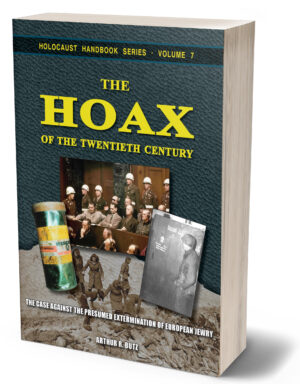 A case in point is Arthur Butz’s Hoax of the Twentieth Century. It was first published in 1976, and its very existence was even acknowledged by mainstream media back then. The book has been around for almost 50 years, much longer than any other academic revisionist book. It became available at a time when social and corporate as well as legal censorship measures were still in their infancy, hence little effective. While several supplements were added to the book over the decades, Butz’s book has never been updated, hence still reflects the knowledge of 50 years ago. Revisionist research has since made huge progress, which is reflected in newer editions of Butz’s book only by meager references to newer works in occasional footnotes added by the editor (me). Yet still, Butz’s book is outselling every other revisionist book, setting a large swath of those seeking answers on a completely misleading track. Today, recommending Butz’s book is like telling a student of evolutionary biology that he should read Darwin’s On the Origin of Species. No sane teacher would do that, and so, I cannot recommend Butz’s book to any newcomer either. It would be irresponsible. Alright, I may be exaggerating a little. Butz’s 500-page book still has a lot of merits, but it is neither succinct, up-to-date nor easy to read, hence not the best path to enlightenment for many if not most novices.
A case in point is Arthur Butz’s Hoax of the Twentieth Century. It was first published in 1976, and its very existence was even acknowledged by mainstream media back then. The book has been around for almost 50 years, much longer than any other academic revisionist book. It became available at a time when social and corporate as well as legal censorship measures were still in their infancy, hence little effective. While several supplements were added to the book over the decades, Butz’s book has never been updated, hence still reflects the knowledge of 50 years ago. Revisionist research has since made huge progress, which is reflected in newer editions of Butz’s book only by meager references to newer works in occasional footnotes added by the editor (me). Yet still, Butz’s book is outselling every other revisionist book, setting a large swath of those seeking answers on a completely misleading track. Today, recommending Butz’s book is like telling a student of evolutionary biology that he should read Darwin’s On the Origin of Species. No sane teacher would do that, and so, I cannot recommend Butz’s book to any newcomer either. It would be irresponsible. Alright, I may be exaggerating a little. Butz’s 500-page book still has a lot of merits, but it is neither succinct, up-to-date nor easy to read, hence not the best path to enlightenment for many if not most novices.
With much milder words, Arthur Butz says even that much in the preface to the 2015 edition of his own book, suggesting to the reader that he should perhaps consult more-recent books to get an idea where Holocaust revisionism stands today (pp. 9, 13 in the 2024 edition):
“I am proud that this book remains of interest to anybody almost 40 years after its first publication. Nevertheless, the age of this text, and the great advances that have subsequently occurred in Holocaust revisionism, require some comments on the value of the book to today’s reader. How can such an old text not be obsolete today? What does today’s reader gain from it? Would it not be better to revise this text to take into account more recent developments? […]
[The Hoax of the Twentieth Century] is still the only book of this sort. A better one would be nice but there are two problems that occur to me. First such a book, if written from the point of view of our knowledge today, would not fit into a single volume. This explains why I reject the idea of trying to bring this book up to date. Such a project would quickly run away from ‘updating,’ resulting in an entirely new work. Any attempt to respect the original content and organization of the book would be a handicap in the updating project. The best single volume for bringing the reader up to date on revisionist scholarship is a compilation of papers by many people, not an integrated work.”
In a footnote, Butz then recommends the compilation of papers contained in the revisionist book Dissecting the Holocaust (HH Vol. 1) or even all volumes of the entire series Holocaust Handbooks (53 volumes as of late 2024).
It goes without saying that one cannot seriously recommend to a novice a 53-volume set of books comprising altogether more than 18,000 pages. In addition, if Dissecting were printed in normal typeset, it would have roughly 900 pages. (It is set in small print with narrow margins, keeping it at just over 600 pages – by cheating). Hence, while Dissecting is a great book, it is arguable whether it is a good one to start one’s journey of discovery. I’ll get back to that farther below.
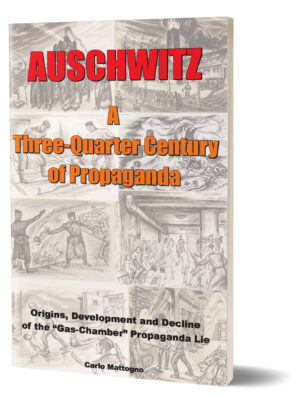 On the upside of box-office successes is Carlo Mattogno’s succinct book Auschwitz: A Three-Quarter Century of Propaganda. (The first, slightly outdated edition of it is freely accessible online here.) The German edition of this book had tremendous sales success in early 2019. Somehow, the book had gone viral in Germany and started selling on Amazon like hot cakes by the hundreds every single day. Amazon then quickly pulled the plug on it and banned the book. (Read more here about this and similar success stories killed by Amazon.) This shows that, given a level playing field, revisionist books can indeed turn into bestsellers. This one is a prime candidate for it, because it present the lies told about Auschwitz since war’s end in a nutshell, easy and pleasant to read. Many of these lies are today recognized as such by mainstream historians, but Mattogno doesn’t stop there. Once he has the reader on a roll, he leads them all the way. With a few ingenious strokes of the pen, this book lays bare the phony nature of the orthodox Auschwitz narrative, their mainstream’s main asset of Holocaust propaganda.
On the upside of box-office successes is Carlo Mattogno’s succinct book Auschwitz: A Three-Quarter Century of Propaganda. (The first, slightly outdated edition of it is freely accessible online here.) The German edition of this book had tremendous sales success in early 2019. Somehow, the book had gone viral in Germany and started selling on Amazon like hot cakes by the hundreds every single day. Amazon then quickly pulled the plug on it and banned the book. (Read more here about this and similar success stories killed by Amazon.) This shows that, given a level playing field, revisionist books can indeed turn into bestsellers. This one is a prime candidate for it, because it present the lies told about Auschwitz since war’s end in a nutshell, easy and pleasant to read. Many of these lies are today recognized as such by mainstream historians, but Mattogno doesn’t stop there. Once he has the reader on a roll, he leads them all the way. With a few ingenious strokes of the pen, this book lays bare the phony nature of the orthodox Auschwitz narrative, their mainstream’s main asset of Holocaust propaganda.
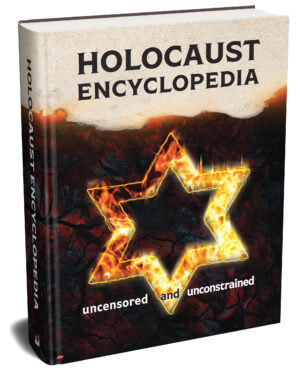 Since 2024, revisionism actually has a new bestseller: Our Holocaust Encyclopedia, believe it or not. With this book, we managed to break through the wall of silence by showing the world the degree of knowledge and proficiency revisionism has gained over the past three decades. Mainstream influencers are impressed by it and have started recommending it to their large audiences, and that makes all the difference. While this is not meant to be a book to read cover to cover, many do exactly this, because almost all entries are full of amazing information so long withheld from the public eye. The world is hungry for this book, and maybe so should you.
Since 2024, revisionism actually has a new bestseller: Our Holocaust Encyclopedia, believe it or not. With this book, we managed to break through the wall of silence by showing the world the degree of knowledge and proficiency revisionism has gained over the past three decades. Mainstream influencers are impressed by it and have started recommending it to their large audiences, and that makes all the difference. While this is not meant to be a book to read cover to cover, many do exactly this, because almost all entries are full of amazing information so long withheld from the public eye. The world is hungry for this book, and maybe so should you.
6. Degree of Coverage of the Topic
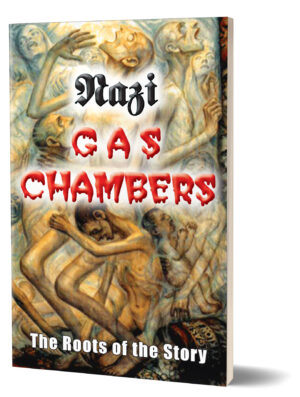
Another question to ask yourself is: how much of the vast territory of the Holocaust do you want covered? If you want all the main aspect addressed but keep it concise, Dalton’s The Holocaust: An Introduction. Exploring the Evidence is your book. If you can cope with an entertaining book that keeps on going, Lectures on the Holocaust: Controversial Issues Cross-Examined should be your choice. Page-count-wise, Dalton’s Debating the Holocaust: A New Look at Both Sides and Kollerstrom’s Breaking the Spell: The Holocaust, Myth & Reality are in between. The latter three are all accessible for free online at HolocaustHandbooks.com, so you can make up your mind before committing to a printed copy (or by a cheapskate and just download the free eBook version). If you just want to know who put the gas into the chambers, hence an explanation on how the gas-chamber story evolved, my succinct book Nazi Gas Chambers: The Roots of the Story is your best bet. If you prefer a rundown on propaganda lies told about Auschwitz, go for Mattogno’s brief Auschwitz: A Three-Quarter Century of Propaganda. Dissecting the Holocaust: The Growing Critique of “Truth” and “Memory” covers a lot of mileage both by volume and subtopics addressed, but it is not an organically grown narrative like the other books, because it is a collection of contributions by numerous authors, each addressing one subtopic. However, not everything that matters about the Holocaust is covered. That is best done by the Holocaust Encyclopedia: Uncensored and Unconstrained, but that’s an entirely different kettle of fish, of course. However, if you are really interested in having quick access to all the information on the Holocaust that matters, that encyclopedia is indubitably the source to consult, whether online or in print.
My Personal Preference
While it may sound like self-promotion if I state that I think my Lectures on the Holocaust are the best introduction into the topic – despite its large size – and I cannot deny that I by force am biased toward my own work, please hear me out before dismissing this claim.
 The Lectures started out as a transcript of actual presentations I gave in 1992 to completely uninitiated audiences who did not know what to expect. I geared every aspect of this presentation toward easing my audience into controversial findings on the Holocaust, among other things by actively engaging the audience, so they get the feeling of being together with me on a mutual journey of discovery, rather than me trying to ram controversial views down their throat. I also tried to be comprehensive in my approach, addressing the topic from many different angles, so as to give everyone in the audience, no matter their professional background or state of knowledge, a way to participate.
The Lectures started out as a transcript of actual presentations I gave in 1992 to completely uninitiated audiences who did not know what to expect. I geared every aspect of this presentation toward easing my audience into controversial findings on the Holocaust, among other things by actively engaging the audience, so they get the feeling of being together with me on a mutual journey of discovery, rather than me trying to ram controversial views down their throat. I also tried to be comprehensive in my approach, addressing the topic from many different angles, so as to give everyone in the audience, no matter their professional background or state of knowledge, a way to participate.
Over the years, I included an increasing number of subtopics and arguments into these Lectures, now in print and audio-book form. In spite of the changes over the decades, I always maintained the book’s unusual dialogue form, this time by me engaging my readers, who I let react and respond to what I present, meaning that, when I let a hostile reader speak, I am actually my own devil’s advocate in that book.
In early 2023, after a journey of 33 years of revisionist research, discoveries and publishing, I sat down to write a Holocaust Encyclopedia, in order to organize the huge amount of information amassed in the 52 volumes of the Holocaust Handbooks that I had published since the early 1990s, and in the numerous historical papers published in various revisionist periodicals. While an encyclopedia is not necessarily the best place to get an introduction into revisionism, it sure is an excellent tool to organize one’s knowledge (or, for the reader, to find knowledge organized). When I sat out to organize this knowledge, where did I start? Actually, I took the subject index of my book Lectures on the Holocaust, and used most of its entries as a starting point to define the entries that needed to be included in an encyclopedia. There could not have been a better place to turn to, because there wasn’t (and still isn’t) any other revisionist book that had as complete a subject index as this one – because there wasn’t any other book covering the territory as densely as that. Sure enough, the Holocaust Encyclopedia eventually published has many more topics that are not addressed in the Lectures (or didn’t make it into its index), because, after all, the Lectures, while having an encyclopedic scope to some degree, have to be economic with what to address and what to omit. An encyclopedia does not, should not, cannot have that restriction.
I admit that buying a book that has more than 500 pages of text is a daunting prospect for many. The rewards you will get out of it will offset the effort, though. Plus, you don’t even have to buy it, as its eBook version can be downloaded free of charge at www.HolocaustHandbooks.com, like all the other books of that series.

My Objective Recommendations
While there is no silver bullet, one-fits-all to ease novices into revisionism, there is a series of recommendations I can make, and have posted for years, on the website www.HolocaustHandbooks.com, which I may reiterate here:
Don’t Know Where to Start? Start with a Free Movie
To ease you into the subject, I recommend that you sit back, relax and watch an introductory documentary. There are several choices we recommend:
 Holocaust, Hate Speech & Were the Germans so Stupid? (35 min.)
Holocaust, Hate Speech & Were the Germans so Stupid? (35 min.)
The late British video-journalist Anthony Lawson, a retired international-prize-winning commercials director, cameraman, ad agency creative director and voice over, expertly introduces the viewer to the basic concepts and consequences of skepticism about the orthodox Holocaust narrative.
 The First Holocaust: The Surprising Origin of the Six-Million Figure (1 hr 10 min.)
The First Holocaust: The Surprising Origin of the Six-Million Figure (1 hr 10 min.)
German-born Chemist, publisher and editor Germar Rudolf reveals how the myth of six million persecuted Jews threatened by a holocaust was created in the late eighteen hundreds (yes 1800s!), became a popular theme during and after the FIRST World War (not the Second), and has stayed with us ever since.
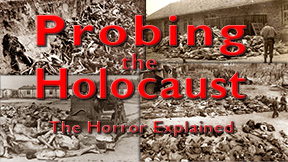 Probing the Holocaust: The Horror Explained (1 hr 36 min.)
Probing the Holocaust: The Horror Explained (1 hr 36 min.)
Documentary filmmaker Germar Rudolf shows with a few pertinent, well-documented examples – the cases of the Dachau, Nordhausen and Bergen-Belsen Camps – why it is important to distrust wartime propaganda about claimed Nazi atrocities, not the least because much of this propaganda has been admitted by mainstream historians to have been mendacious.
If you’re hungry for more, you can browse any of our documentaries, or, if you want to delve into the matter even deeper, you may want to start reading our books, whose information density is easily tenfold that of a documentary.
Read a Leaflet or a Brochure
- The Holocaust Controversy: The Case for Open Debate: This letter-size flyer puts into a nutshell what Holocaust revisionism is all about. You can take the above PDF file to your local printer or copy shop, and have them print as many copies as you like, for your own use, to hand it out, even to sell it, if you wish. Please note that the flyer is meant to be folded twice; instructions on how can be found at the bottom of the second PDF page. Most printers and copy shops can do the folding automatically for you.
- Letter-Size Flyer HOLOCAUST REVISIONISM IN 10 MINUTES by Thomas Dalton, PhD: This double-sided letter-size leaflet also gives the novice a brief introduction into what Holocaust Revisionism is. It has a different format (plain letter-size), writing style and contents than the above leaflet. You can take the above PDF file to your local printer or copy shop as well, and have them print as many copies as you like, for your own use, to hand it out, even to sell it, if you wish.
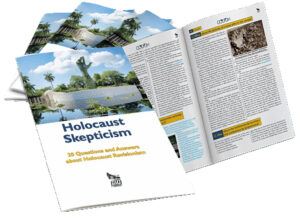 Holocaust Skepticism: 20 Questions and Answers about Holocaust Revisionism: This stapled, full-color brochure of 19 pages introduces the novice to the concept of Holocaust revisionism, and answers 20 tough questions, among them: What does Holocaust revisionism claim? Why should I take Holocaust revisionism more seriously than the claim that the earth is flat? What about the pictures of corpse piles in the camps? How about the testimonies by survivors and confessions by perpetrators? What does it matter whether prisoners died from disease or poison gas? You can take the above PDF file to your local printer or copy shop, and have them print as many copies as you like (color or black & white), for your own use, to hand it out, even to sell it, if you wish. You can also order hard copies of it here.
Holocaust Skepticism: 20 Questions and Answers about Holocaust Revisionism: This stapled, full-color brochure of 19 pages introduces the novice to the concept of Holocaust revisionism, and answers 20 tough questions, among them: What does Holocaust revisionism claim? Why should I take Holocaust revisionism more seriously than the claim that the earth is flat? What about the pictures of corpse piles in the camps? How about the testimonies by survivors and confessions by perpetrators? What does it matter whether prisoners died from disease or poison gas? You can take the above PDF file to your local printer or copy shop, and have them print as many copies as you like (color or black & white), for your own use, to hand it out, even to sell it, if you wish. You can also order hard copies of it here. The Holocaust: Facts versus Fiction: This 36-page booklet gives a condensed overview of the latest research on the Holocaust with references to literature where you can find more on the subject. It also explains why the issue is important and why many governments brutally suppresses dissenting views. It contains lots of references to free e-books and videos, and it lists the entire book program of Armreg Ltd (at the time of going to press). You can download it right here .
The Holocaust: Facts versus Fiction: This 36-page booklet gives a condensed overview of the latest research on the Holocaust with references to literature where you can find more on the subject. It also explains why the issue is important and why many governments brutally suppresses dissenting views. It contains lots of references to free e-books and videos, and it lists the entire book program of Armreg Ltd (at the time of going to press). You can download it right here .
 Consult the Revisionist Holocaust Encyclopedia
Consult the Revisionist Holocaust Encyclopedia
The new standard reference work summarizing in 586 nutshell entries the research results of skeptical Holocaust research. This 642-page letter-size “Nuke Book” gives you an uncensored and unconstrained look at all the pertinent evidence that upholds the orthodox Holocaust narrative: the true, the false, and the mendacious. It also exposes the various forces and influences that have dictated how this narrative was formed, and how it is protected from skeptical prying eyes. Learn about the biggest propaganda campaign mankind has ever seen, and how it braced the postwar world psychologically. This encyclopedia gives you all the information you ever wanted, and information you didn’t even know exists, right at your fingertips. This trail-blazing work is accessible free of charge online at www.NukeBook.org and www.HolocaustEncyclopedia.com. You can buy eBook versions and printed copies of this myth-slayer at https://armreg-co.uk
Read Our Books
Most of our books on the “Holocaust” you can download, read and even distribute free of charge as an eBook (as PDF and, for most, as ePub). Our series Holocaust Handbooks currently encompasses 53 books. Many of these books are highly specialized, which can be rather confusing and discouraging for most of you who just want it in a nutshell. Hence, below we give a brief guide as to what we recommend for those dipping their feet into this topic for the first time, or for those who want a somewhat deeper, yet still general immersion into it.
The first book is unfortunately commercial in nature and is not available as free downloads (and it isn’t even part of our series). The others, however, and indubitably also the most up-to-date and comprehensive ones, are available as a free download, so maybe you want to start there. When reading the review I quote below for each book, please keep in mind that each reviewer probably only read this one book among those listed here. Therefore, these reviews are of little use to compare the books.
Holocaust 101
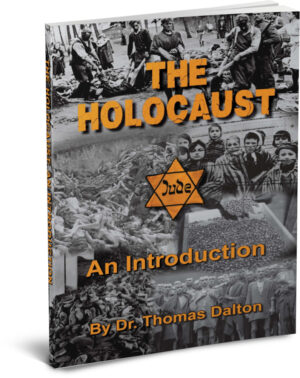 The best brief introduction into the topic of the Holocaust is Thomas Dalton’s The Holocaust: An Introduction. It has merely 115 pages of text in a handy, small paperback format of 5×8 inches, and it costs only £11.5 as a hard copy. Amazon customer E.J. Peterson, a verified buyer of the book, wrote the following brief review about it (on March 6, 2017, Amazon blocked all our books and deleted all associated book reviews, so you can’t find the reviews quoted here anymore – so much about freedom of speech…):
The best brief introduction into the topic of the Holocaust is Thomas Dalton’s The Holocaust: An Introduction. It has merely 115 pages of text in a handy, small paperback format of 5×8 inches, and it costs only £11.5 as a hard copy. Amazon customer E.J. Peterson, a verified buyer of the book, wrote the following brief review about it (on March 6, 2017, Amazon blocked all our books and deleted all associated book reviews, so you can’t find the reviews quoted here anymore – so much about freedom of speech…):
“Phenomenal. A fantastic starting point.
For a 115 page book, it is a truly shocking and eye-opening work. I cannot recommend this highly enough. Honestly, subject your accepted opinion on the matter to this 1 hour read and see where you sit after that.” – Learn more about this book here.
Holocaust 201
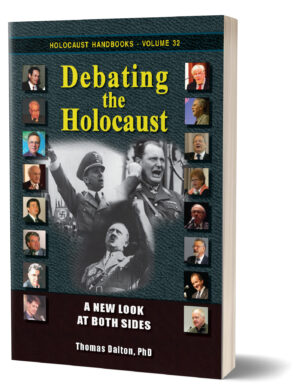 The above-mentioned brief introduction into the topic is a condensation of a more encompassing study which Dalton first published in 2008: Debating the Holocaust: A New Look at Both Sides. He released updated editions of that book in 2015 and 2017. In this book, Dalton studies the topic more thoroughly by juxtaposing the most important arguments of all contending sides in the raging debate about the “Holocaust,” which, some say, should not be debated in the first place. The book has some 300 pages of text of a larger format (6×9 inches). At £28 as a hard copy, it’s still a steal. Amazon customer “patito,” a verified buyer of the book, wrote this brief review about it:
The above-mentioned brief introduction into the topic is a condensation of a more encompassing study which Dalton first published in 2008: Debating the Holocaust: A New Look at Both Sides. He released updated editions of that book in 2015 and 2017. In this book, Dalton studies the topic more thoroughly by juxtaposing the most important arguments of all contending sides in the raging debate about the “Holocaust,” which, some say, should not be debated in the first place. The book has some 300 pages of text of a larger format (6×9 inches). At £28 as a hard copy, it’s still a steal. Amazon customer “patito,” a verified buyer of the book, wrote this brief review about it:
“Most important Holocaust book in this moment
The updates to the 2015 edition are especially important as the author corrects and forwards a proposal towards the end. A very good compilation of the real state of affairs regarding the actual evidence for one argument or the other. The Epilogue is especially critical to understanding the whole picture.”
Learn more about this book here.
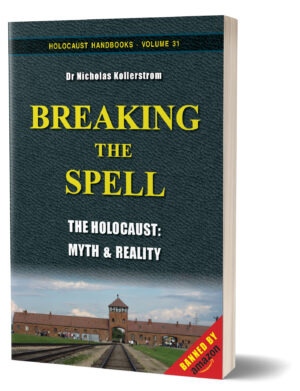 In his book Breaking the Spell: The Holocaust, Myth & Reality, now available in its 2019 5th edition, science historian Dr. Nicholas Kollerstrom explains the Holocaust issue for the common reader from a scientific, but also from a societal point of view. This paperback book has some 250 pages of text (6×9 inches). At £25 as a hard copy, it has been our best-selling book ever since it was first published. Amazon customer “Giordano Bruno,” a Amazon-verified buyer of the book, wrote this brief review about it:
In his book Breaking the Spell: The Holocaust, Myth & Reality, now available in its 2019 5th edition, science historian Dr. Nicholas Kollerstrom explains the Holocaust issue for the common reader from a scientific, but also from a societal point of view. This paperback book has some 250 pages of text (6×9 inches). At £25 as a hard copy, it has been our best-selling book ever since it was first published. Amazon customer “Giordano Bruno,” a Amazon-verified buyer of the book, wrote this brief review about it:
“Myth Busting
An interesting and informative book, particularly how it expresses that the “Holocaust” has basically become a sacred religion that cannot be challenged even by science. Anyone who dares to criticize or explain that certain narratives of the holocaust are physically impossible is instantly branded as a heretic and excommunicated. Would definitely recommend reading it!”
Learn more about this book here.
Holocaust 301
 At 510 pages of text, the Lectures on the Holocaust have been characterized as encyclopedic in their coverage of the topic, yet at the same time as a truly riveting read. Written in an unusual dialogue form, it draws you right into the debate the author engages in. This is a brand-new edition issued in July 2017, which is greatly improved by new material. It costs merely £36.50 as a hard copy. Amazon customer “HolocaustHistory channel,” a verified buyer of the book (he bought it from us, not from Amazon), wrote this brief review about it:
At 510 pages of text, the Lectures on the Holocaust have been characterized as encyclopedic in their coverage of the topic, yet at the same time as a truly riveting read. Written in an unusual dialogue form, it draws you right into the debate the author engages in. This is a brand-new edition issued in July 2017, which is greatly improved by new material. It costs merely £36.50 as a hard copy. Amazon customer “HolocaustHistory channel,” a verified buyer of the book (he bought it from us, not from Amazon), wrote this brief review about it:
“Outstanding
This is without doubt one of the best treatments of the holocaust debate. Rudolf is judicious and moderate throughout, and packs in a great deal of information. By writing dialogues, he gives himself the opportunity to give clear answers to many the questions that will occur to the reader. If you are at all interested in the holocaust, you have to read this book.”
Learn more about this book here, or download it as a free PDF file right here.
Honorable Mention
Three more books are worth mentioning here, even though their scope is somewhat limited:
 My own, already-mentioned 120-page book Nazi Gas Chambers: The Roots of the Story. While I was writing the above-mentioned Holocaust Encyclopedia, I had a number of epiphanies resulting from the fact that I had to get so many facts straight, and make everything be consistent and coherent. I started connecting dots between seemingly isolated facts which I had never seen before. One of them was the realization that there was actually a plot to create the orthodox Holocaust narrative as we know it today, at least when it comes to the part claiming the use of homicidal gas chambers for the mass murder of Jews. That conspiracy is not what most people think it is, though. Hence, I thought it important to take those facts, scattered throughout the Encyclopedia, and put them all together in one book, connecting the dots for the reader, and explaining it all. It is a slim book, but very enlightening and rewarding to read. Therefore, if you are happy to learn the essentials just about that core aspect of the Holocaust narrative, this is the book to read.
My own, already-mentioned 120-page book Nazi Gas Chambers: The Roots of the Story. While I was writing the above-mentioned Holocaust Encyclopedia, I had a number of epiphanies resulting from the fact that I had to get so many facts straight, and make everything be consistent and coherent. I started connecting dots between seemingly isolated facts which I had never seen before. One of them was the realization that there was actually a plot to create the orthodox Holocaust narrative as we know it today, at least when it comes to the part claiming the use of homicidal gas chambers for the mass murder of Jews. That conspiracy is not what most people think it is, though. Hence, I thought it important to take those facts, scattered throughout the Encyclopedia, and put them all together in one book, connecting the dots for the reader, and explaining it all. It is a slim book, but very enlightening and rewarding to read. Therefore, if you are happy to learn the essentials just about that core aspect of the Holocaust narrative, this is the book to read. My own, already-mentioned 200-page book Bungled: “Denying the Holocaust”, which is a detailed debunking of Deborah Lipstadt’s highly influential book Denying the Holocaust. Its value lies precisely in the fact that it addresses all the false claims and prejudices spread widely by Mrs. Lipstadt about the Holocaust, its revision, and the evidence that is the basis of our knowledge. It exposes Lipstadt’s fraudulent methods of systematically misrepresenting evidence, and how she makes a plethora of wild claims without ever backing them up with anything. It is an eyeopener for the reader to realize the incredible incompetence and mendacity of the orthodoxy’s “most valuable asset.”
My own, already-mentioned 200-page book Bungled: “Denying the Holocaust”, which is a detailed debunking of Deborah Lipstadt’s highly influential book Denying the Holocaust. Its value lies precisely in the fact that it addresses all the false claims and prejudices spread widely by Mrs. Lipstadt about the Holocaust, its revision, and the evidence that is the basis of our knowledge. It exposes Lipstadt’s fraudulent methods of systematically misrepresenting evidence, and how she makes a plethora of wild claims without ever backing them up with anything. It is an eyeopener for the reader to realize the incredible incompetence and mendacity of the orthodoxy’s “most valuable asset.” Carlo Mattogno’s 120-page book Auschwitz: A Three-Quarter Century of Propaganda, which focuses entirely on the Auschwitz Camp, hence has a somewhat limited scope. However, its value lies in a succinct exposure of the many lies that have been told about Auschwitz, and which are today admitted by mainstream historians to have been untrue. It shows the reader that mainstream lies are the norm rather than the exception, and that sweeping them under the carpet after their exposure is a common feature in our societies. With that inertia of healthy skepticism gained, the reader is then prepared to go along with the author on his succinct journey through revisionist research results deconstructing what’s left of the orthodoxy’s Auschwitz horror show.
Carlo Mattogno’s 120-page book Auschwitz: A Three-Quarter Century of Propaganda, which focuses entirely on the Auschwitz Camp, hence has a somewhat limited scope. However, its value lies in a succinct exposure of the many lies that have been told about Auschwitz, and which are today admitted by mainstream historians to have been untrue. It shows the reader that mainstream lies are the norm rather than the exception, and that sweeping them under the carpet after their exposure is a common feature in our societies. With that inertia of healthy skepticism gained, the reader is then prepared to go along with the author on his succinct journey through revisionist research results deconstructing what’s left of the orthodoxy’s Auschwitz horror show.
Bibliographic information about this document: Inconvenient History, 2024, Vol. 16, No. 2
Other contributors to this document:
Editor’s comments:
